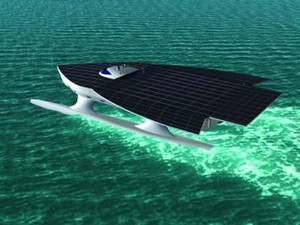Largest ever solar yacht crosses Atlantic, visits climate conference
by Sail-World Cruising Round-up on 15 Dec 2010

Turanor - powered by 38,000 solar cells SW
Everything begins with a dream, and the dream to build the world's largest solar yacht and circumnavigate the earth with her is on its way to becoming true. Launched last April in Kiel in Germany, the 85 tonne catamaran Türanor left Monaco in September and crossed the Atlantic Ocean last month, claiming a record for the fastest crossing powered purely by the sun.
She then sailed south and made a very appropriate appearance at the United Nations climate change conference in Cancun in Mexico.
Its 64-year-old German owner, Immo Stroeher, says: 'The theme of this ship and its around-the-world voyage is to create consciousness about what you can do with solar energy.'
The name Turanor, which is borrowed from Tolkien's famed 'Lord of the Rings' means 'power of the sun', the yacht's goal is to circumnavigate the world in 160 days.
Turanor is equipped with 38,000 solar cells, and travels at a steady pace of 7.5 knots. She will
please conventional sailors with her silence in operation. It is topped by scores of photovoltaic panels, with a total area of more than 600 sq metres, covering, as can be seen in the images, most of the catamaran’s surface.
More panels adorn outriggers on the starboard, port, and stern sections, all of which are able to retract during rough weather. Captured solar energy is stored in the world’s largest lithium ion battery, which will power the boat’s emissions-free, (and silent) electric motor.
The boat is financed by Ströher, a German entrepreneur and solar pioneer, in close cooperation with Knierim Yachtbau GmbH, the shipyard that built the catamaran
'The mission of the skippers is to chase the sun,' said Dany Faigaux, a member of PlanetSolar, the Swiss team behind the ambitious project. 'Up until now, sailing navigation has involved working with the three parameters of the waves, wind and tide. But we've added two new dimensions – namely, sunlight and the lithium ion battery. It's a completely new form of energy management.'
The catamaran, designed for its energy-saving ability to 'slice' rather than 'ride' through waves, will store energy in its batteries by day. It can run on its stored energy in the absence of sunlight for around three days at 7.5 knots, the speed of an average oil tanker. At slower speeds it could run for up to 15 days, according to its makers.
Türanor, which is travelling along an equatorial route – to take most advantage of the sunshine – is being helped by French meteorologists who advise the most efficient path along which to steer it according to current conditions and forecasts.
If it is a particularly cloudy day, they might recommend a diversion to sunnier parts, even if the route turns out to be longer. 'Its all about maximising its energy efficiency,' said Faigaux.
The voyage is intended not so much to revolutionise sea travel – the technology requires the vessel to be as light as possible, so it would not be suitable for heavy container ships – as to prove the under-exploited potential of solar energy.
'We want to be the Phileas Fogg of the 21st century,' says 38-year old Domjan, the project's pioneer, referring to his famed story, 'Around the World in 80 Days'. 'But beyond Jules Verne's dream, our project is meant to serve the environment and to enable solar energy to replace fossil fuels, and to motivate engineers and scientists to develop these technologies,' he says. Appropriately, one of the patron's of the project is Jean Verne, the great-grandson of the French author of Around the World in Eighty Days.
Gerard d'Aboville, his fellow skipper for the voyage, is no stranger to maritime challenges, having become the first person to row across the Atlantic Ocean in 1980.
'We'll have to learn a new kind of navigation,' he said. 'It's very different from any of the other challenges I've faced, which is what makes it so interesting. It's strongly symbolic for the future of solar energy, but I would not dare to say that tomorrow a merchant boat or a passenger plane will be powered by the sun.'
If you want to link to this article then please use this URL: www.sailworldcruising.com/78111